Bold prints, elegant colours and trendy designs worthy of appearing on high fashion runways were hardly what we expected when we first heard of Chinthaka Rathnayake and his little batik workshop and store. That’s exactly what we found though at Kandurata Batiks, tucked away in a quiet suburb on the outskirts of Kandy. While it was a relief to get away from the tightly packed flurry that is the Kandy city, Chinthaka’s friendly welcome that included milk toffee and tea was cheering. Laid-back and relaxed, we found he was easy to talk to, as he good-naturedly poked fun at us for going round in circles before finally arriving at his store (Kandy has a knack for doing this to us!).
The display area of Kandurata Batiks is a riot of colours and designs and I found the urge to launch myself into the tangle of colours irresistible. As I browsed through the shelves and clothes-hangers neatly arranged with an array of garments including shawls, dresses, tops, t-shirts, bandanas, beach wraps and sarongs, I had to keep reigning in my shopaholic tendencies by reminding myself that I am currently trying to travel the whole country on a shoe-string budget. So attractive was the batik on each of the pieces.

Tangles of colours and designs at Kandurata Batiks
What I found most captivating is that Chinthaka and his team had managed to infuse a modern, youthful energy into the age-old art of batik. While some of the designs on bed spreads, bed runners, pillow cases and cushion covers were certainly traditional, new designs had been created to adorn garments like beach wraps and bandanas. A group of turtles stared out of a beach wrap and a fiery sun shone forth from a yellow bandana. In other instances, designs with a traditional feel had been applied to contemporary outfits like dresses and t-shirts. One of the dresses that caught my eye was a pale pink with a little batik motif by the hem; it struck me as almost Boho-chic.

Beach wraps adorned with contemporary, sometimes whimsical, designs
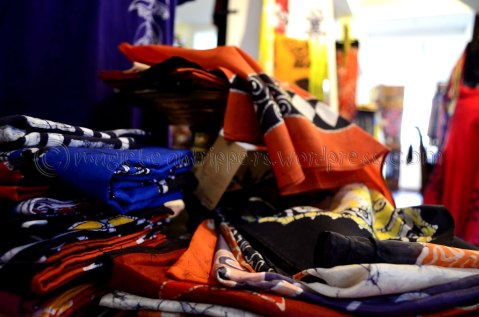
A collection of bandanas create a riot of colour

A bedspread with more traditional designs
In addition to the casual outfits, there were also several formal pieces. The satin and silk fabrics used for a collection of blouses and kurthas gave the batik designs a grand lustre. Even chiffon shawls and pashminas had been brightened up with batik. In fact, there seemed to be no fabric that Chinthaka had not adorned with batik; a couple of earth-toned shawls were – I was surprised to find – woven out of pineapple fibre.

Cheery chiffon shawls

Even Pashmina shawls sport batik
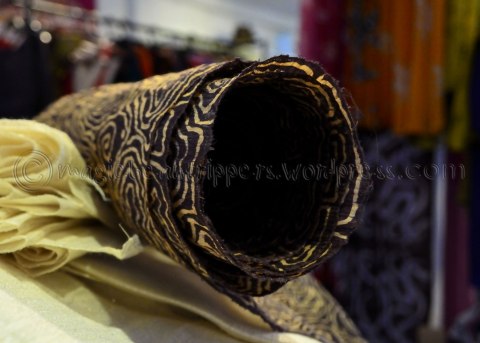
A shawl spun out of pineapple fibre. Beneath it is a roll of the same type of fabric before being embellished with batik.
Having begun his career as a model working in Qatar and Malaysia, Chinthaka has always had a passion for art and design. This is what led him to study Designing with Natural Dyes in Hyderabad and soon after, he came back home to set up Kandurata Batiks. It has only been six years since its inception, but the store houses a wide range of painstakingly made batik products, for which Chinthaka has already won acclaim. In 2011 he secured first place at the Kuala Lumpur International Batik Convention and was awarded as the Best Entrepreneur of the Central Province of Sri Lanka the same year. More recently, Chinthaka won Gold and Silver for two of his creations at Shilpa 2012.
Each design at the store is one-of-a-kind and hand made with only natural dyes – as we found in Chinthika’s workshop. Always open for curious customers to take a peek, the workshop had a distinctly waxy smell about it. When we entered, two ladies were using melted wax to paint floral designs on cotton fabric. Their dextrous strokes conveyed the meticulous nature of the work they were doing. They never used blocks, meaning every design is hand-painted and unique. Draped on chairs, tables, racks and basically every available surface were garments and fabrics, stiff with wax and ready to be immersed in dye.

Intricate work
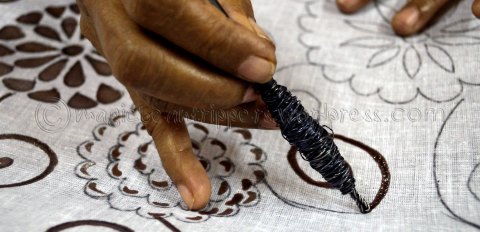
Each of the pieces is entirely hand-made
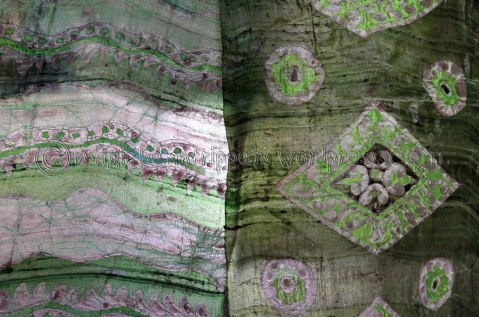
After the wax is painstakingly applied, the garments are ready to be dipped in natural dye
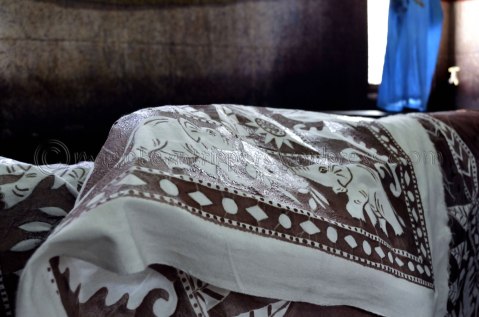
The brownish areas of the fabric have been coated with wax
Wax is one of the fundamental elements that go into the creation of beautiful batik designs. Melted wax – Chinthaka uses a mixture of mostly paraffin wax with a small quantity of bee’s wax – is applied to the area of the design that must be left colourless. Once it has dried, it is immersed in a natural dye bath, which stains the exposed area of the fabric. It is the cracks in the wax that allow bits of dye to seep in and create the intricate lines that I love about batik. Thereafter, more colours can be added to create more complex designs by waxing and dying as many times as required. After the fabric has absorbed the dye, the wax is removed by heating the wax and scraping or sponging it off. Finally, the fabric with the completed design is treated with a mordant, which intensifies the stains caused by the natural dyes.

A mixture of white paraffin wax and golden bee’s wax is used to seal off the area of the design that must be left colourless. The wax is often reused, which is why the chunk of wax on the left has taken on a brownish colour.

The dyes used to create the batik designs
Creating the designs is a collaborative effort between Chinthaka and an artist, employed especially for this task. Chinthaka finds inspiration for his creations in objects as diverse as Palampore – an ancient variety of Indian bedspread created for royalty during the 18th century – and the diamond shaped mould used to make aluwa, a traditional Sri Lankan sweet. Chinthaka had created his own batik version of the Palampore for the World Batik Council show in Kuala Lumpur in December 2011. Flipping through photographs of models wearing his designs at the Kuala Lumpur International Batik Convention, I was surprised by the contemporary vibe radiating from the dress sporting the designs sparked by a humble aluwa mould.

A painting of the Kandy Perahera by Chinthaka’s talented artist

One of the designs inspired by an aluwa mould
Chinthaka’s travels through South Asia, the cradle of the art of batik, also bring him into contact with many a muse. In Laos he found an elaborately designed antique piece of cloth, which he was able to acquire. Much of the fabric and other raw materials are sourced during his travels to this part of the world, especially Malaysia, Thailand, India, Singapore and Laos. The material woven out of pineapple fibre is from the Philippines.

The elaborately designed antique
Just as we were leaving, Uncle Tony, who manages the store for Chinthaka, pulled out an inconspicuous wrap, hidden away in a corner among several flamboyantly patterned pieces. “I have to especially show you this one,” he said. “It was entirely designed and created by Chinthaka.”

Designed and created entirely by Chinthaka
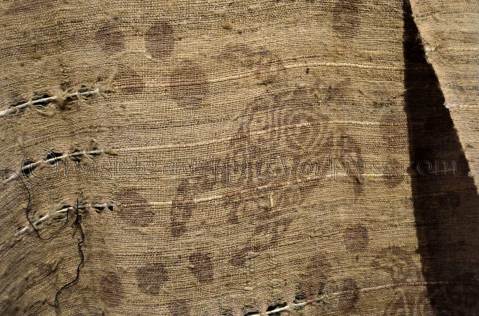
A closer look of the beach wrap designed and created entirely by Chinthaka
Taking a closer look at the pretty wrap, I found the colours chosen were simple and unassuming; the wrap was an understated beige with slightly darker brown patterns adorning it. At the same time the turtle designs lent it a trendy and artistic tone, the sort of work executed by someone with impeccable taste. The wrap reminded me of the dynamic, young proprietor of Kandurata Batiks; it seemed a reflection of the personality of its maker.
You can visit Chinthaka’s store and workshop at 17/30, New Housing Scheme, Thiwanka Bodhi Mawatha, Kandy, Sri Lanka. Or call him on + 94 812 234 140 or +94 773 286 402
© The Magic-Bean Trippers Prior written consent of the authors must be obtained to reproduce, copy, modify or adapt any part of this blog or any of its contents.
